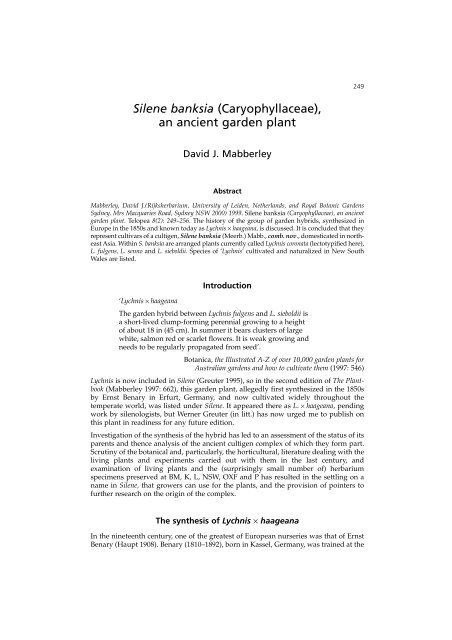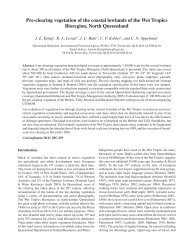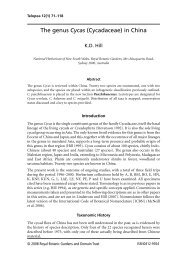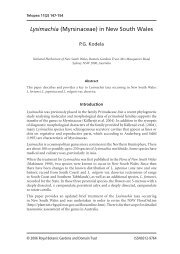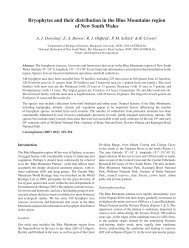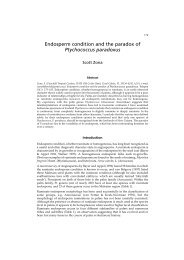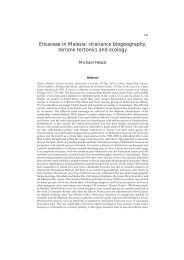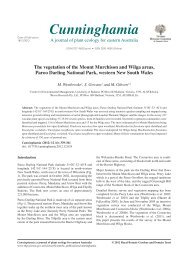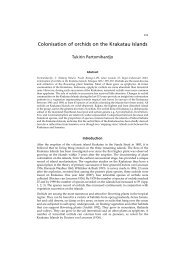Silene banksia - Royal Botanic Gardens
Silene banksia - Royal Botanic Gardens
Silene banksia - Royal Botanic Gardens
You also want an ePaper? Increase the reach of your titles
YUMPU automatically turns print PDFs into web optimized ePapers that Google loves.
<strong>Silene</strong> <strong>banksia</strong> (Caryophyllaceae),<br />
an ancient garden plant<br />
David J. Mabberley<br />
Abstract<br />
Mabberley, David J.(Rijksherbarium, University of Leiden, Netherlands, and <strong>Royal</strong> <strong>Botanic</strong> <strong>Gardens</strong><br />
Sydney, Mrs Macquaries Road, Sydney NSW 2000) 1999. <strong>Silene</strong> <strong>banksia</strong> (Caryophyllaceae), an ancient<br />
garden plant. Telopea 8(2): 249–256. The history of the group of garden hybrids, synthesized in<br />
Europe in the 1850s and known today as Lychnis × haageana, is discussed. It is concluded that they<br />
represent cultivars of a cultigen, <strong>Silene</strong> <strong>banksia</strong> (Meerb.) Mabb., comb. nov., domesticated in northeast<br />
Asia. Within S. <strong>banksia</strong> are arranged plants currently called Lychnis coronata (lectotypified here),<br />
L. fulgens, L. senno and L. sieboldii. Species of ‘Lychnis’ cultivated and naturalized in New South<br />
Wales are listed.<br />
Introduction<br />
‘Lychnis × haageana<br />
The garden hybrid between Lychnis fulgens and L. sieboldii is<br />
a short-lived clump-forming perennial growing to a height<br />
of about 18 in (45 cm). In summer it bears clusters of large<br />
white, salmon red or scarlet flowers. It is weak growing and<br />
needs to be regularly propagated from seed’.<br />
<strong>Botanic</strong>a, the Illustrated A-Z of over 10,000 garden plants for<br />
Australian gardens and how to cultivate them (1997: 546)<br />
Lychnis is now included in <strong>Silene</strong> (Greuter 1995), so in the second edition of The Plantbook<br />
(Mabberley 1997: 662), this garden plant, allegedly first synthesized in the 1850s<br />
by Ernst Benary in Erfurt, Germany, and now cultivated widely throughout the<br />
temperate world, was listed under <strong>Silene</strong>. It appeared there as L. × haageana, pending<br />
work by silenologists, but Werner Greuter (in litt.) has now urged me to publish on<br />
this plant in readiness for any future edition.<br />
Investigation of the synthesis of the hybrid has led to an assessment of the status of its<br />
parents and thence analysis of the ancient cultigen complex of which they form part.<br />
Scrutiny of the botanical and, particularly, the horticultural, literature dealing with the<br />
living plants and experiments carried out with them in the last century, and<br />
examination of living plants and the (surprisingly small number of) herbarium<br />
specimens preserved at BM, K, L, NSW, OXF and P has resulted in the settling on a<br />
name in <strong>Silene</strong>, that growers can use for the plants, and the provision of pointers to<br />
further research on the origin of the complex.<br />
The synthesis of Lychnis × haageana<br />
In the nineteenth century, one of the greatest of European nurseries was that of Ernst<br />
Benary (Haupt 1908). Benary (1810–1892), born in Kassel, Germany, was trained at the<br />
249
250 Telopea 8(2): 1999<br />
Erfurt firm of Haage and Schmidt and later worked in nurseries in Belgium and<br />
England besides elsewhere in Germany. In 1843 he founded his own firm in Erfurt<br />
and, by 1908, it had become one of the most influential in Europe with contracted<br />
growers not only in many countries there but even in the tropics. Not only was the<br />
business introducing new plants into cultivation (Benary himself was commemorated<br />
in the name of a greenhouse plant, Seemannia benaryi Regel (i.e. Gloxinia sylvatica<br />
(Kunth) Wiehler, Gesneriaceae), described from material collected by Benedict Roezl<br />
in South America), but the gigantic concern was also dedicated to improving garden<br />
stock through hybridization and selection on a grand scale.<br />
In the 1850s, Benary’s firm, which specialized in, amongst other things, carnations,<br />
pinks and other Caryophyllaceae (in German ‘Nelken’), successfully hybridized two<br />
campions, then called Lychnis fulgens, said to be from Siberia, and L. sieboldii from<br />
Japan. The resultant plant was named L. haageana after Friedrich Adolphe Haage<br />
(1796–1866) of the firm of Benary’s old employer in Erfurt. It was released to the trade<br />
from Erfurt by Benary but also from Ghent (Gand), Belgium at the same time (Lemaire<br />
& Verschaffelt 1859). In January 1859, Verschaffelt published a fine illustration of the<br />
plant raised at Ghent from Benary’s seeds, but if he or Lemaire, who validated the<br />
name, preserved any specimen, this is now lost, like the rest of any herbarium either<br />
of them may have had.<br />
The hybrid had actually been raised before, probably just before the work at Benary’s<br />
nursery, by Eduard Ortgies (1829–1916), superintendent of the University botanic<br />
garden in Zürich, Switzerland (Mabberley 1985), with L. sieboldii as the pollen parent<br />
(Ortgies 1860). Moreover, according to K. Koch’s Wochenschrift (2: 173–4, 1859), the<br />
plant had also appeared in French nurserymen’s catalogues as ‘Lychnis sieboldiifulgens’,<br />
offered as a product of the Lemoine nursery in Nancy. Ortgies’s and Benary’s<br />
hybrids, at least, were identical. Both Benary and Ortgies found that selfing the hybrid<br />
produced a range of forms from the ‘fulgens’ type with small, red flowers, to the<br />
‘sieboldii’ type with larger, white flowers, plants with brick-red and salmon-pink<br />
flowers being among the fertile offspring. The hybrids soon became fashionable and<br />
were illustrated in periodicals in Britain as early as 1859 according to Index londinensis.<br />
Now they are grown in all temperate parts of the world, including the cooler parts of<br />
Australia, being easily raised from seed as well as cuttings: different forms have been<br />
given cultivar names. As pointed out by Planchon (1876), many of the forms have<br />
more similarities to ‘L. fulgens’ than to L. sieboldii, a plant now considered conspecific<br />
with L. coronata Thunb.<br />
In recent years, the hybrids have been crossed with the gardeners’ Maltese Cross,<br />
L. chalcedonica L., a Russian species notable for its dense heads of scarlet flowers, to<br />
give L × arkwrightii Heydt, a striking cultivar being ‘Vesuvius’ (Huxley 1992: 137).<br />
The parents<br />
The name of Lychnis coronata, which species was introduced to cultivation in England<br />
by John Fothergill in 1774 (Aiton 1789), was based on a plant cultivated in Japan,<br />
collected and drawn by C.P. Thunberg (Hb. 11163, the basis for his drawing 136 — see<br />
below). The conspecific L. grandiflora was based on a cultivated specimen grown in<br />
Vienna. The basis for L. sieboldii Van Houtte ex Planchon was also a cultivated plant,<br />
grown in Belgium as imported from Japan by von Siebold for sale as L. grandiflora var.<br />
alba, but renamed by Van Houtte as a new species for commercial release in 1855.<br />
While formally describing it as a species, though, Planchon thought it perhaps a<br />
selected garden form and perhaps the plant discussed by Engelbert Kaempfer in his<br />
Amoenitatum Exoticarum: 873 (1712) as ‘Sen sjun ra, vulgo Ganpi. Lychnis coronaria,
Mabberley, <strong>Silene</strong> <strong>banksia</strong> (Caryophyllaceae) 251<br />
flore in herbaceum abicante…petalis dentatis, apiculis cinereis. Eadem flore albo’,<br />
included in L. coronata by Thunberg. Zuccarini (in Siebold & Zuccarini 1835–41) noted<br />
that this flowered in May and June (hence the name ‘cut summer gauze’ of Steward<br />
(1958: 113)).<br />
A second plant described on the same page in Kaempfer’s book, ‘Literatis & vulgo<br />
Senno. Lychnis coronaria, foliis calycibus lanuginosis, flore dilutiori sanguineo, petalis<br />
laciniatis, apicibus colore violaceo saturatis’, which Thunberg had as L. chalcedonica,<br />
was included in L. senno of Siebold & Zuccarini, who noted that it flowered in July and<br />
August (therefore the ‘cut autumn gauze’of Steward (1958: 113)). It was also described<br />
from cultivated plants collected in Japan, where, like L. coronata (as L. grandiflora),<br />
Siebold and Zuccarini (1835-41: 97, t. 48 — ‘Colitur frequens in Japoniae hortis’)<br />
considered it not to be wild but probably introduced from China, having been<br />
described by Chinese writers. To L. senno Tang (1996) has joined L. bungeana, which<br />
was collected in a Beijing garden by Bunge and was distributed as seeds by Fischer,<br />
from St Petersburg, those received at the Horticultural Society in London in 1835 being<br />
the origin of the plant figured by Lindley in the <strong>Botanic</strong>al Register (see below). Lindley<br />
noted it was ‘very like a one-flowered state of L. fulgens’, though it was first described<br />
as Agrostemma bungeana by David Don, based on a plant grown in England from seeds<br />
sent from Germany.<br />
Lychnis fulgens, the other parent of L × haageana, is maintained as distinct from L. senno<br />
by Tang (1996). L. fulgens was originally distributed from the Gorenki garden in<br />
Russia, again by Fischer, and a plant raised from seeds in 1819 by Thomas Jenkins in<br />
his nursery in New Road, Marylebone, London, was illustrated by Sims in the<br />
<strong>Botanic</strong>al Magazine (see below). The commonly grown form often has several-flowered<br />
heads, unlike the original description of L. fulgens, which was based on a plant<br />
‘floribus solitariis’, grown in the botanic garden in Berlin; L. fulgens is said to be native<br />
in Siberia, but Tang (1996) records it for China too, with L. senno (including<br />
L. bungeana) also in both.<br />
Quite independent of the work on these Japanese and European cultivated plants, a<br />
specimen of L. coronata in China was described by the Portuguese missionarynaturalist,<br />
João de Loureiro (1717–1791) as Hedona sinensis, another name based on a<br />
cultivated plant, ‘Colitur ob venustatem Cantone Sinarum’. Indeed, the plant had long<br />
been grown in China, figuring in ‘The Hundred Flowers’ of seventeenth-century<br />
painters (e.g. Wiedner et al. 1988: Cat. 34) but was accurately depicted much earlier,<br />
being drawn by Xu Xi in the Five Dynasties (Tenth Century) as reproduced by She &<br />
Yuhas (1973: fig. 4).<br />
Shortly after Loureiro’s work, a very similar form with brick-red flowers was<br />
described as Agrostemma <strong>banksia</strong> Meerb. (1798), a name based on yet another cultivated<br />
plant, this time grown in Leiden, Netherlands, where Nicolaas Meerburg[h]<br />
(1734–1814) was curator of the Hortus <strong>Botanic</strong>us from 1774 until his death. Later, in the<br />
nineteenth century, the plant was described afresh, yet again from cultivated material,<br />
this time in France (Carrière 1871), from a plant grown from ‘oillet’ seeds sent by a M.<br />
Coullet from Yokohama, Japan in 1867. Of that batch only one seed germinated but,<br />
within two seasons of selfing, a whole range of colour forms including white with<br />
variously incised petals were produced. While describing it as new, Elie Carrière<br />
(1818–1896) admitted it might merely be a robust form of the well known cultivated<br />
plant, suggesting that it and L. haageana might merely be forms of ‘L. grandiflora’<br />
(i.e. L. coronata).
252 Telopea 8(2): 1999<br />
<strong>Botanic</strong>al and horticultural solutions<br />
All the binomials in current use for this group are thus ultimately based on cultivated<br />
plants, mostly grown away from their presumed native distribution, mainland east<br />
Asia. Based on these striking cultivated plants, botanists have insisted on keeping up<br />
distinct species (L. cognata, ‘L. fulgens’, L. senno and L. coronata in mainland Asia, and,<br />
in Japan, L. sieboldii (including L. speciosa), ‘L. fulgens’, L. senno and L. coronata<br />
(the last two as cultivated plants from China)), though, dealing with living plants,<br />
horticulturists in the last century took a very different view. After his experimental<br />
work, Ortgies (1860) concluded that the parents of L. × haageana were conspecific,<br />
confirming an opinion published the year before by K. Koch, commenting on Benary’s<br />
work (see above). Rohrbach (1869) considered L. sieboldii a ‘lusus’ of L. fulgens var.<br />
typica Regel and L. × haageana merely an intraspecific cross.<br />
British and French hortculturists, at least, effectively consolidated this, in amalgamating<br />
all the cultivated plants as varieties of one species, L. fulgens. So, Nicholson’s Illustrated<br />
Dictionary of Gardening (see below) has var. grandiflora (i.e. L. coronata, syn. L. grandiflora),<br />
var. sieboldii (i.e. L. sieboldii) and var. haageana (L. × haageana) while Désiré Bois (1896: 45–46),<br />
from his experience in the Jardin des Plantes in Paris, wrote, ‘Toutes ces plantes ne<br />
different au point de vue scientifique que par des caractères peu emportants et très<br />
variables comme le degré de villosité (abondance plus ou moins grande de poils fins<br />
et courts), le nombre des fleurs dans les inflorescences, les dimensions des pétales<br />
simplement échancrés ou plus ou moins découpés’. Contrary to perceived wisdom,<br />
then, it is horticulturists who were recognizing a smaller number of species than<br />
botanists were, and still are.<br />
Further research directions<br />
The distribution of L. coronata (L. grandiflora) has been said to be China and Japan, but<br />
I have seen no definitely wild material. If, as Siebold and Zuccarini suggested, the<br />
forms seen in Japan were, like so many cultivated Japanese plants, such as<br />
chrysanthemums, for example, selected from Chinese plants already cultivated for a<br />
long time in China, it might well be that L. coronata has a hybrid origin itself. This<br />
would certainly explain the extraordinary array of plants produced by some forms<br />
after selfing. If this is indeed so, what are the wild plants from which L. coronata has<br />
been derived? ‘L. fulgens’ is morphologically similar to the Chinese L. laciniata Maxim.<br />
(non Lam. = L. flos-cuculi L.), i.e. L. wilfordii (Regel) Maxim.(L. fulgens var. wilfordii<br />
Regel, of which Rohrbach (1869: 185) recognized two forms, the wild f. mandschurica<br />
Rohrb. from mainland Asia and f. japonica Rohrb. from cultivation in Japan). Its<br />
relationship with L. coronata needs to be examined, as does that with what has been<br />
called L. cognata Maxim. (reduced to a variety of L. fulgens by Rohrbach): if such plants<br />
represent forms of one parent species, then L × haageana would merely be a backcross<br />
between one distinctive form within the existing hybrid complex and one close to a<br />
putative wild parent. However, the possibility of other parent species being involved<br />
cannot yet be ruled out and allied wild species in both China and Japan, notably<br />
L. miqueliana Rohrb., need to be studied with this in mind.<br />
The most parsimonious hypothesis on present evidence is that ‘L. fulgens’ in<br />
cultivation is that form most like the wild type and that L. senno, true L. fulgens and<br />
L. bungeana are forms nearer it than is L. coronata, which includes Hedona sinensis,<br />
Agrostemma <strong>banksia</strong>, L. sieboldii and L. speciosa. Nonetheless, this is, as yet, hypothesis<br />
and the relationship between all these plants, and even L × arkwrightii (and therefore<br />
L. chalcedonica itself), needs clarification through controlled hybridization experiments,<br />
preferably using wild-collected material, before a definitive scheme can finally be<br />
arrived at.
Mabberley, <strong>Silene</strong> <strong>banksia</strong> (Caryophyllaceae) 253<br />
<strong>Silene</strong> subg. Lychnis<br />
The controversial generic limits in the <strong>Silene</strong>–Lychnis group are resolved at last (see<br />
Greuter 1995) and many genera, including Lychnis (now subg. Lychnis (L.) E. Krause),<br />
are finally ‘sunk’ in <strong>Silene</strong>. Lychnis fulgens, one of the supposed parents of the ‘hybrid’,<br />
is now <strong>Silene</strong> fulgens (Sprengel) E. Krause, though, as explained above, the description<br />
of the type resembles L. senno, so perhaps the ‘wild’ plant would need another name<br />
if it were maintained as a separate species. Although the resolution of the name in<br />
<strong>Silene</strong> for it, and any other parent, awaits further work, that for the ancient cultivated<br />
plants themselves can be resolved here, giving horticulturists a useable name under<br />
which to arrange recognized cultivars.<br />
In dealing with the long-cultivated forms of the plant, the ideology of Ortgies (1860),<br />
Nicholson, and Bois in keeping the ‘species’ together is followed, here by arranging<br />
the cultivars in informal groups under the oldest name for any plant in the cultigen<br />
complex, and referring L. × haageana to it as a synonym. The name in <strong>Silene</strong> cannot be<br />
based on either L. coronata or its synonym, L. grandiflora, however, because of existing<br />
homonyms; the next available name is Hedona sinensis Lour., but this cannot be used<br />
either, because of S. chinensis Hort. ex Bosse, another but different cultivated species.<br />
Dan Nicolson kindly commented (in litt.), ‘Since chinensis and sinensis are listed among<br />
the voted examples [in ICBN] of examples of ‘epithets so similar that they are likely to<br />
be confused’, it would seem that one cannot avoid treating them as homonyms under<br />
Art. 53.4, even if one has fallen into synonymy. Perhaps I should say that if you were<br />
to publish, others would probably feel they would have to treat your new combination<br />
as a later homonym and provide a new name’. The oldest useable epithet for the whole<br />
complex therefore appears to come from Agrostemma <strong>banksia</strong> Meerb.:<br />
<strong>Silene</strong> <strong>banksia</strong> (Meerb.) Mabb., comb. nova<br />
Agrostemma <strong>banksia</strong> Meerb., Pl. Select. Icon. Pict.: [12, as ‘Agrostema’], t. 28 (1798);<br />
Schrader, J. Bot. 2: 152 (1799).<br />
Type: cultivated at Leiden, Netherlands, N. Meerburg (not preserved?). No material<br />
found at L, or in E, where there are Meerburg specimens from Giseke’s herbarium<br />
(H. Noltie, pers. comm.) so the illustration might serve as iconotype; this falls into the<br />
Coronata Group below.<br />
<strong>Silene</strong> <strong>banksia</strong> is taken here as the name for the ancient cultivated plant, apparently a<br />
cultigen, including all crosses and backcrosses in the complex raised originally in<br />
?China, but later in Japan and Europe; if further work demonstrates that the cultigen<br />
has a hybrid origin as suspected above, it would then be written ‘<strong>Silene</strong> × <strong>banksia</strong>’. The<br />
specific epithet commemorates Joseph Banks (1743–1820), who visited the Hortus<br />
<strong>Botanic</strong>us in Leiden in 1773 and had 59 of Kaempfer’s drawings of Japanese plants<br />
(though not including any of ‘Lychnis’), now at BM, published in 1791: it is<br />
orthographically comparable with Erica <strong>banksia</strong> Andr. (Ericaceae) of the same era.<br />
The ‘wild’ and cultivated plants in the complex can be provisionally arranged in<br />
informal groups (in which the botanical names and their types are listed for<br />
convenience) as follows. Note that some cultivar names were used in the ‘cultivated<br />
variety’ sense in the last century and were given ‘formal’ botanical names at the time:<br />
they are retained here in modern form to ensure continuity.<br />
a. <strong>Silene</strong> <strong>banksia</strong> Senno Group<br />
(Nearest to one putative parental wild type, which probably has multiflowered<br />
inflorescences of small red flowers with laciniate petals like Lychnis wilfordii (Regel)<br />
Maxim. (L. fulgens var. wilfordii Regel), but plants more compact and inflorescences<br />
fewer-flowered.)
254 Telopea 8(2): 1999<br />
Lychnis fulgens Fischer ex Sprengel, Nov. Provent.: 26 (1818); Sims, Bot. Mag.: t. 2104 (1819); Huxley<br />
(1992: 137); Tang (1996: 275).<br />
Agrostemma fulgens (Sprengel) Doell, Rhein. Fl.: 643 (1843).<br />
<strong>Silene</strong> fulgens (Sprengel) E. Krause in Sturm, Fl. Deutschl., ed. 2, 5: 96 (1901).<br />
Type: Cultivated in the Berlin botanic garden, Germany, c. 1817, ? K. Sprengel (W?, lost [Sprengel’s<br />
Caryophyllaceae were in W]). The first description of L. fulgens refers to solitary flowers with bifid<br />
petals, Sims’s plant having flowers always in threes. Later authors have used the name for severalflowered<br />
specimens.<br />
Agrostemma bungeana D. Don in Sweet, Fl. Gard. II, 7: t. 317 (before Mar. 1836) & Hort. Belge 3: 106<br />
(Mar. 1836); Drapiez in t.c.: 249, t. 63 (Aug. 1836).<br />
Lychnis bungeana (D. Don) Fischer ex Lindley, Bot. Reg.: t. 1864 (1836).<br />
Type: cultivated in England by Patrick Neill from material received from Messrs Booth’s Flotbeck<br />
Nurseries, near Hamburg, Germany, n.v. (? not preserved, in which case the plate would be<br />
‘iconotype’). Plants raised from seeds from Booth were grown at the Glasgow <strong>Botanic</strong> Garden<br />
where they flowered in September 1835 and one was illustrated in Bot. Mag. t. 3594 (1837), where<br />
a footnote indicates that Bunge’s original material came from a garden in Beijing. N.B. Extant<br />
specimens, without localities, include one ex Herb. Bunge (P!) and ‘Lychnis bungeana Fisch. in litt.<br />
1833’ ex Herb. Prescot (OXF!): both have flowers in threes.<br />
Lychnis senno Siebold & Zucc., Fl. Jap. 1: 98, t. 49 (1839); Tang (1996: 276).<br />
Type: cultivated in Japan, P.F. von Siebold (holo L!).<br />
Apparently none of the cultivars in commerce is named.<br />
b. <strong>Silene</strong> <strong>banksia</strong> Coronata Group<br />
(Large flowers with petals shallowly lobed, praemorse to dentate; here falls the type<br />
of S. <strong>banksia</strong>. The relationship between this and other <strong>Silene</strong> species needs to be<br />
examined as those are perhaps involved in the parentage of the cultivars in this group.)<br />
Named cultivars include:<br />
‘Grandiflora’ (large red flowers)<br />
Lychnis coronata Thunb. in Murray, Syst. Veg.: 435 (1784) & Nova Acta Soc. Sci. Upsal. 4: 35, 39 (1784)<br />
& Fl. Japon.: 187 (1784), Hortus Third: 688 (1976); Huxley, l.c. (1992); Tang (1996: 275), non <strong>Silene</strong><br />
coronata Bonj. ex Colla (1833).<br />
[Lychnis grandiflora Jacq. ‘Abart’ coronata Siebert & Voss, Vilmorin’s Blumengärtn. ed. 3: 105<br />
(1894), nom. illeg.]<br />
Type: cultivated in Japan, C.P. Thunberg 11163 (lecto, selected here, UPS — fiche (P) ! (N.B. right<br />
hand specimen on sheet is that figured in Thunberg’s drawing reproduced in Thunberg’s Drawings<br />
of Japanese Plants (1994): t. 136).<br />
Lychnis grandiflora Jacq., Coll. 1: 149 (Jan–Sept 1787), Ic. Pl. Rar.: t. 84 (?1787).<br />
Exemix grandiflora (Jacq.) Raf., Aut. Bot.: 27 (1840).<br />
Agrostemma grandiflora (Jacq.) Doell, Rhein. Fl.: 643 (1843).<br />
Lychnis fulgens Fischer ex Spreng. var. grandiflora (Jacq.) Nichols., Ill. Dict. Gard. 2: 306, t. 488 (1885),<br />
nom. illeg.<br />
Lychnis × haageana ‘Grandiflora’, Hortus Third, l.c. (1976); Huxley, l.c. (1992).<br />
<strong>Silene</strong> grandiflora (Jacq.) Ohashi & H. Nakai, J. Jap. Bot. 71: 110 (1996), non Franchet (1886).<br />
Type: cultivated in Vienna, Austria, n.v. (W?, lost; perhaps not preserved, in which case Jacquin’s<br />
illustration would make an appropriate type).<br />
Hedona sinensis Lour., Fl. Cochinch.: 286 (1790), non <strong>Silene</strong> chinensis Hort. ex Bosse, Blumengärt.<br />
3: 445 (?1829, n.v.), ed. 2, 3: 388 (1842) = ?<br />
Type: China, cultivated in Canton, J. de Loureiro s.n. (?holo P–LOUR!).<br />
Lychnis grandiflora Jacq. var. tetrapetala Séringe in DC., Prodr. 1: 386 (1824).<br />
Type: G?, n.v.
Mabberley, <strong>Silene</strong> <strong>banksia</strong> (Caryophyllaceae) 255<br />
‘Speciosa’ (large scarlet flowers)<br />
Lychnis speciosa Carr., Rev. Hort. 42: 530 + t. (1871).<br />
Lychnis fulgens var. speciosa (Carr.) Siebert & Voss, Vilmorin’s Blumengärtn:, ed. 3: 105 (1894).<br />
[Lychnis grandiflora var. gigantea Hort. ex Siebert & Voss, l.c., nom. in synon.]<br />
[Lychnis japonica speciosa Hort. ex Siebert & Voss, l.c., nom. in synon.]<br />
Lychnis coronata var. speciosa (Carr.) L. Bailey, Cyclop. Am. Hort. 2: 956 (1900).<br />
Type: Cultivated in France from seeds sent from Yokohama, Japan, and raised by Fleuriste, n.v.<br />
(?not preserved, in which case the plate would be an ‘iconotype’).<br />
‘Sieboldii’ (flowers white)<br />
Lychnis sieboldii Van Houtte ex Planchon, Fl. Serres 10: 31 (1835); Regel, Gartenfl. 12: 82, t. 391 fig. 5<br />
(1863); Huxley, l.c. (1992).<br />
[Lychnis grandiflora var. alba Siebold ex Planchon, l.c., nom. in synon.; Bois, Dict. Hort.: 792 (1893–9),<br />
nom. nud.]<br />
Lychnis fulgens var. sieboldii (Planchon) Nichols., t.c.: 306; t. 490 (1885).<br />
Lychnis grandiflora var. sieboldii (Planchon) Siebert & Voss, l.c.<br />
Lychnis coronata var. sieboldii (Planchon) L. Bailey, l.c.<br />
Type: cultivated in Belgium, n.v., probably not preserved, in which case the plate would be<br />
‘iconotype’. (N.B. There survives a Siebold sheet of a wild-collected plant, but without locality —<br />
P.F. von Siebold, P!).<br />
c. <strong>Silene</strong> <strong>banksia</strong> Haageana Group<br />
(Crosses between ‘L. fulgens’ (i.e. a plant in the Senno Group) and a white-flowered<br />
cultivar (‘Sieboldii’) in the Coronata Group, and offspring through selfing.)<br />
Lychnis × haageana Benary ex Lem., Ill. Hort. 6: ad t. 195 (Jan 1859); Regel, Gartenfl. 12: 82, t. 391,<br />
figs. 3, 4 (1863); Planchon, Fl. Serres II, 12: t. 2322 (1876); Turrill in Curtis, Bot. Mag.[178] n.s. t. 314<br />
(1958); Huxley, l.c.(1992).<br />
Lychnis fulgens Fischer ex Spreng. var. haageana (Lem.) Nicholson, Ill. Dict. Gard. 2: 306 + t. 489 (1885).<br />
Lychnis grandiflora Jacq. var. haageana (Lem.) Bois, Dict. Hort.: 792, t. 554 (1893–9).<br />
Type (lectotype [icon], chosen here): ‘Lychnis Haageana’, Illust. Hort.: t. 195 (1859).<br />
Named cultivars include:<br />
‘Hybrida’ (flowers red)<br />
Hortus Third: 688 (1976); Huxley, l.c. (1992).<br />
? Lychnis haageana var. hybrida Hort. ex Rodigas, Bull. Arbor. Belge 1897: 105, t. 15.<br />
‘Salmonea’ (flowers salmon pink)<br />
Hortus Third: 688 (1976); Huxley, l.c. (1992).<br />
In the last century, at least, there were also ‘Lychnis fulgens var. Haageana grandiflora<br />
Hort.’ and ‘var. Haageana nana Hort.’ (Nichols. & Mottet, Dict. Prat. Hort. 3: 212 (1895–6)).<br />
Conclusion: ‘Lychnis’ in Australia<br />
The plants in cultivation formerly referred to as Lychnis fulgens, L. × haageana, etc., can<br />
therefore be referred to simply as <strong>Silene</strong> <strong>banksia</strong>, named cultivars as S. <strong>banksia</strong><br />
‘Sieboldii’ and S. <strong>banksia</strong> ‘Grandiflora’, for example.<br />
Although grown in New South Wales, no form of S. <strong>banksia</strong> is known to be naturalized,<br />
though, of species recently referred to Lychnis, both S. chalcedonica (L.) E. Krause and<br />
S. coronaria (L.) Clairv. (Mediterranean to C Asia) have become so. Other species<br />
cultivated in Australia and lately referred to Lychnis are <strong>Silene</strong> flos-cuculi (L.) Clairv.<br />
(Europe), S. flos-jovis (L.) Greuter & Burdet (European Alps), S. suecica (Lodd.) Greuter<br />
& Burdet (L. alpina L. Europe, NE N America), and S. viscosa (L.) Pers. (Eurasia).
256 Telopea 8(2): 1999<br />
Acknowledgments<br />
I am indebted to Norbert Kilian (B) for getting access to information on Benary’s firm<br />
and to Ernst G. Benary for precise details, to Henry Noltie (E) for information on<br />
Meerburg specimens, to Peter Valder (NSW) for information on early Chinese plant<br />
illustrations, to Dan Nicolson (US) for nomenclatural guidance, and to Alistair Hay<br />
(NSW) for critically reading an early draft of this paper.<br />
References<br />
Aiton, W. (1789) Hortus Kewensis. 3 vols. (Nicol: London).<br />
Bois, D. (1896) Atlas des plantes de jardins et d’appartements exotiques et Européennes. Texte. (Librarie<br />
des Sciences Naturelles: Paris).<br />
Carrière, E. (1871) Lychnis speciosa. Revue horticole 42: 530–531 + tab.<br />
Greuter, W. (1995) <strong>Silene</strong> (Caryophyllaceae) in Greece: a subgeneric and sectional classification.<br />
Taxon 44: 543–581.<br />
Haupt, H. (1908) Die Erfurter Kunst- und Handelsgärtnerei in ihrer geschichtlichen Entwickelung<br />
und wirstschaftlichen Bedeutung dargestellt. Abhandlungen des staatswissenschaftlichen Seminars<br />
zu Jena 5(1).<br />
Huxley, A. (ed., 1992) The New <strong>Royal</strong> Horticultural Society Dictionary of Gardening vol. 3. (Macmillan :<br />
London).<br />
Lemaire, C. & Verschaffelt, A. (1859) Lychnis Haageana (hybrida). Lychnide de Haage. L’Illustration<br />
horticole 6: t. 195.<br />
Mabberley, D.J. (1985) ‘Die neuen Pflanzen von Ch. Huber & Co. in Hyères’. Taxon 34: 448–456.<br />
Mabberley, D.J. (1997) The Plant-book. A portable dictionary of vascular plants. Edn 2. (Cambridge<br />
University Press: Cambridge)<br />
Ortgies, E. (1860) Lychnis hybr. Haageana. Gartenflora 9: 60–2.<br />
Planchon, J.E. (1876) Lychnis haageana. Flore des Serres II, 12: t. 2322.<br />
Rohrbach, P. (1869) Synopsis der Lychnideen. Linnaea 36: 70–270.<br />
She, C. & Yuhas, L. (1973) Masterpieces of Chinese painting in the National Palace Museum. Supplement.<br />
(National Palace Museum: Taipei).<br />
Siebold, P.F. & Zuccarini, J.G. (1839–41) Flora japonica, vol. 1. (The authors: Leiden).<br />
Steward, A.N. (1958) Manual of vascular plants of the Lower Yangtze Valley, China. (Oregon State<br />
College: Corvallis).<br />
Tang, C. (1996) Lychnis. Pp. 267–278 [in Chinese]. Florae Reipublicae Popularis Sinicae 26.<br />
(Science Press).<br />
Wiedner, M. et al. (1988) Views from Jade Terrace. Chinese women artists 1300–1912. (Indianapolis<br />
Museum of Art; Rizzoli: New York).<br />
Manuscript received 23 October 1998<br />
Manuscript accepted 3 March 1999


